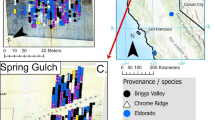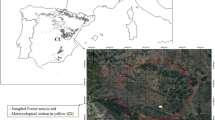Abstract
Large-scale biogeographical shifts in forest tree distributions are predicted in response to the altered precipitation and temperature regimes associated with climate change. Adaptive forest management to climate change experienced in either stable or rapidly changing environments must consider this fact when carrying out reforestation programs or specifically assisted population migration for conservation purposes. The aim of this study was to compare field performance of eleven seed sources of Aleppo pine outplanted in core and marginal habitats and to assess their phenotypic plasticity for further screening under specific conditions in particular reforestation areas. We hypothesize that current marginal habitat due to low temperature is shifting toward conditions found on the core habitat and that current core habitat will shift toward warmer and drier marginal habitat. Our study reproduced real conditions of reforestation in potential future climatic conditions. Results suggest that it is difficult to predict Aleppo pine provenances’ performance in different natural sites from their performance at a single location, even though ‘Levante interior’ and ‘La Mancha’ seed sources showed the best overall response among sites. On a site basis, provenances were matched in groups according to their survival and growth responses. Seedlings grown from local seed sources or seed orchards performed better on the core habitat. However, as conditions shifted to marginal habitats, seedlings from climatically similar regions performed better than local sources at least in the short term; our findings suggest that new plantations in areas already affected by global change could be better adapted if they use alternative seed sources.




Similar content being viewed by others
References
Agúndez ID, Degen B, von Wuehlisch G, Alia R (1997) Genetic variation of Aleppo pine (Pinus halepensis mill.). For Gen 4(4):201–209
Aitken SN, Yeaman S, Holliday JA, Wang T, Curtis-McLane S (2008) Adaptation, migration or extirpation: climate change outcomes for tree populations. Evol App 1:95–111. doi:10.1111/j.1752-4571.2007.00013.x
Alía R, Garcia del Barrio JM, Iglesias S, Mancha JA, de Miguel J, Nicolas JL, Perez F, Sanchez de Ron D (2009) Regiones de procedencia de especies forestales en España. Organismo Autonomo Parques Nacionales, Madrid
Atzmon N, Moshe Y, Schiller G (2004) Ecophysiological response to severe drought in Pinus halepensis Mill. trees of two provenances. Plant Ecol 171:15–22
Bariteau M (1992) Variabilité géographique et adaptation aux contraintes du milieu méditerranéen des pins de la section halepensis : résultats (provisoires) d’un essai en plantations comparatives en France. Ann Sci For 49:261–276
Benito-Garzón M, Alía R, Robson TM, Zavala MA (2011) Intra-specific variability and plasticity influence potential tree species distributions under climate change. Glob Ecol Biogeogr 20:766–778
Climent J, Prada MA, Calama R, Chambel MR, Sánchez de Ron D, Alía R (2008) To grow or to seed: ecotypic variation in reproductive allocation and cone production by young female Aleppo pine (Pinus halepensis, Pinaceae). Am J Bot 95(7):833–842
Cortina J, Vilagrosa A, Trubat R (2013) The role of nutrients for improving seedling quality in drylands. New For. doi:10.1007/s11056-013-9379-3
Cregg BM, Zhang JW (2001) Physiology and morphology of Pinus sylvestris seedlings from diverse sources under cyclic drought stress. For Ecol Manage 154:131–139
del Campo AD, Navarro-Cerrillo RM, Hermoso J, Ibáñez AJ (2007a) Relationships between root growth potential and field performance in Aleppo pine. Ann For Sci 64:541–548
del Campo AD, Navarro-Cerrillo RM, Hermoso J, Ibáñez AJ (2007b) Relationships between site and stock quality in Pinus halepensis Mill. reforestation on semiarid landscapes in eastern Spain. Ann For Sci 64:719–731
del Campo AD, Hermoso J, Flors J, Lidón A, Navarro-Cerrillo RM (2011) Nursery location and potassium enrichment in Aleppo pine stock 2. Performance under real and hydrogel-mediated drought conditions. Forestry 84(3):235–245
Esteban GL, Martín JA, de Palacios P, Fernández FG, López R (2010) Adaptive anatomy of Pinus halepensis trees from different Mediterranean environments in Spain. Trees 24:19–30. doi:10.1007/s00468-009-0375-3
European Forest Institute (2009) A Mediterranean Forest Research Agenda-MFRA. 2010-2020. Mediterranean Regional Office–EFIMED. www.efimed.efi.int/files/attachments/efimed/mediterranean_forest_research_agenda_2010-2020.pdf
FAO (2013) State of Mediterranean Forests 2013.www.fao.org/docrep/017/i3226e/i3226e.pdf
Ferrio JP, Voltas J (2005) Carbon and oxygen isotope ratios in wood constituents of Pinus halepensis as indicators of precipitation, temperature and vapour pressure deficit. Tellus B 57:164–173
Gandullo J, Sánchez-Palomares O (1994) Site ecology of Spanish pines, ICONA, Ministry of Agriculture, fisheries and food, Madrid (in Spanish)
Garrido A, Willaarts B, López-Gunn E, Rey D (2012) Considerations on climate variability and change in Spain. In: De Stefano L, Ramón Llamas M (eds) Water, agriculture and the environment in Spain can we square the circle? CRC Press, Boca Raton, pp 191–202
Giorgi F, Lionello P (2008) Climate change projections for the Mediterranean region. Glob Planet Change 63:90–104
Grivet D, Sebastiani F, González-Martínez SC, Vendramin GG (2009) Patterns of polymorphism resulting from long-range colonization in the Mediterranean conifer Aleppo pine. New Phytol 184:1016–1028
Hernandez EI, Vilagrosa A, Pausas JG, Bellot J (2010) Morphological traits and water use strategies in seedlings of Mediterranean coexisting species. Plant Ecol 207:233–244
IPCC (2001) The Scientific Basis. In: Houghton JT, Ding Y, Griggs DJ, Noguer M, Van Der Linden PJ, Dai X, Maskell K, Johnsson CA (eds) Climate Change 2001. Cambridge University Press, Cambridge, p 881
Kaplan EL, Meier P (1958) Nonparametric estimation from incomplete observations. J Am Stat Assoc 53:457–481
Landis TD, Dumroese RK, Haase DL (2010) The container tree nursery manual: Seedling processing, storage, and outplanting. vol. 7. USDA For. Serv., Agr. Handbook. 674, Washington, p 192
Matesanz S, Valladares F (2013) Ecological and evolutionary responses of Mediterranean plants to global change. doi: 10.1016/j.envexpbot.2013.09.004
Mayr S (2007) Limits in water relations. Trees at their upper limit. In: Wieser G, Tausz M (eds) Tree life limitation at the Alpine timberline. Springer, Berlin, pp 145–162
McDowell N, Pockman WT, Allen CD, Breshears DD, Cobb N, Kolb T, Plaut J, Sperry J, West A, Williams DG, Yepez EA (2008) Mechanisms of plant survival and mortality during drought: why do some plants survive while others succumb to drought? New Phytol 178:719–739
Metzger MJ, Bunce RGH, Leemans R, Viner D (2008) Projected environmental shifts under climate change: European trends and regional impacts. Environ Conserv 35(1):64–75
Mulet JM, Martin DE, Loewith R, Hall MN (2006) Mutual antagonism of target of rapamycin and calcineurin signaling. J Biol Chem 281(44):33000–33007
Oliet JA, Puértolas J, Planelles R, Jacobs DF (2013) Nutrient loading of forest tree seedlings to promote stress resistance and field performance: a Mediterranean perspective. New For 44:649–669. doi:10.1007/s11056-013-9382-8
Oliver J, Bogino S, Spiecker H, Bravo F (2012) Climate impact on growth dynamic and intra-annual density fluctuations in Aleppo pine (Pinus halepensis) trees of different crown classes. Dendro 30:35–47
Persson B (1994) Effect of provenance transfer on survival in nine experimental series with Pinus sylvestris (L.) in northern Sweden. Scand J Forest Res 9:275–287
Potter KM, Hargrove WW (2012) Determining suitable locations for seed transfer under climate change: a global quantitative method. New For 43(5–6):581–599
Puértolas J, Gil L, Pardos JA (2005) Effects of nitrogen fertilization and temperature on frost hardiness of Aleppo pine (Pinus halepensis Mill.) seedlings assessed by chlorophyll fluorescence. Forestry 78(5):501–511
Quézel P, Médail F (2003) Ecologie et biogéographie des forêts du basin méditerranéen. Elsevier (Collection Environnement), Paris, 573 p
Ræbild A, Graudal L, Khan SR (2003) Evaluation of a Prosopis cineraria provenance trial at Dagar Kotli, Pakistan. Trial no. 23 in the arid zone series Results and Documentation No. 28. Danida Forest Seed Centre, Humlebaek, Denmark
Rehfeldt GE, Tchebakova NM, Parfenova YI, Wykoff WR, Kuzmina NA, Milyutin II (2002) Intraspecific responses to climate change in Pinus sylvestris. Glob Change Biol 8:912–929
Reich PB, Oleksyn J (2008) Climate warming will reduce growth and survival of Scots pine except in the far north. Ecol Lett 11:588–597. doi:10.1111/j.1461-0248.2008.01172.x
Sáenz-Romero C, Beaulieu J, Rehfeldt GE (2011) Altitudinal genetic variation among P. patula in growth chambers simulating global warming temperatures. Agrocien 45:399–411
Schiller G, Atzmon N (2009) Performance of Aleppo pine (Pinus halepensis) provenances grown at the edge of the Negev desert: a review. J Arid Environ 73:1051–1057
Schmidtling RC (1994) Use of provenance tests to predict response to climatic change: loblolly pine and Norway spruce. Tree Physiol 14:805–817
Soto A, Robledo-Arnuncio JJ, González-Martínez J, Smouse BE, Alía R (2010) Climatic niche and neutral genetic diversity of the six Iberian pine species: a retrospective and prospective view. Mol Ecol 19(7):1396–1409
Sultan SE, Spencer HG (2002) Metapopulation structure favors plasticity over local adaptation. Am Nat 160:271–283
Tognetti R, Michelozzi M, Giovannelli A (1997) Geographical variation in water relations, hydraulic architecture and terpene composition of Aleppo pine seedlings from Italian provenances. Tree Physiol 17:241–250
United Nations, United Nations Economic Commission for Europe & Food and Agriculture Organization of the United Nations (2011) The European Forest Sector Outlook Study II 2010-2030. 107 pp. http://www.fao.org/docrep/016/ap406e/ap406e00.pdf
Vallejo VR, Smanis A, Chirino E, Fuentes D, Valdecantos A, Vilagrosa A (2012) Perspectives in dryland restoration: approaches for climate change adaptation. New For 43:561–579
van Kleunen M, Fischer M (2007) Progress in the detection of costs of phenotypic plasticity in plants. New Phytol 176:727–730
Vennetier M, Vilà B, Liang E, Guibal F, Taahbet A, Gadbin-Henry C (2007) Impact of climate change on pines forest productivity and on the shift of a bioclimatic limit in Mediterranean area. In: Leon e V, Lovreglio R (ed) Proceedings of the international workshop MEDPINE 3: conservation, regeneration and restoration of Mediterranean pines and their ecosystems. Bari : CIHEAM, 2007. pp 189–197 (Options Méditerranéennes : Série A. Séminaires Méditerranéen s; n. 75)
Villar-Salvador P, Puértolas J, Cuesta B, Peñuelas JL, Uscola M, Heredia-Guerrero N, Rey Benayas JM (2012) Increase in size and nitrogen concentration enhances seedling survival in Mediterranean plantations. Insights from an ecophysiological conceptual model of plant survival. New For. doi 10.1007/s11056-012-9328-6
Voltas J, Chambel MR, Prada MA, Ferrio JP (2008) Climate-related variability in carbon and oxygen stable isotopes among populations of Aleppo pine grown in common-garden tests. Trees 22:759–769
Williams MI, Dumroese RK (2013) Preparing for climate change: forestry and assisted migration. J For 111(4):287–297
Zobel B, Talbert JJ (1984) Applied forest tree improvement. Wiley, New York, pp 75–116
Acknowledgments
This study is a part of two research projects: “Application of molecular biology techniques in forest restoration in Mediterranean environments, PAID-05-11” funded by the Universitat Politècnica de València (UPV), program for supporting R&D of new multidisciplinary research lines; and the contract subscribed between the UPV and the Ministry of Environment, Rural and Marine affairs (Centro Nacional de Recursos Genéticos Forestales de Alaquàs) through its public partnership TRAGSA titled: “Study of seedling quality and field performance of 12 seed sources of Pinus halepensis Mill.” The authors are grateful to Amparo Pedros-Marí for field work in La Hunde, to the Valencia Regional Government (CMAAUV, Generalitat Valenciana) and VAERSA staff for their support in allowing the use of the experimental forest of La Hunde. We thank Dr. Kasten Dumroese from USDA Forest Service, Rocky Mountain Research Station for his critical and valuable comments on the draft manuscript. Also, we thank the anonymous referees for their comments, which significantly improved the final manuscript.
Author information
Authors and Affiliations
Corresponding author
Electronic supplementary material
Below is the link to the electronic supplementary material.
Rights and permissions
About this article
Cite this article
Taïbi, K., del Campo, A.D., Mulet, J.M. et al. Testing Aleppo pine seed sources response to climate change by using trial sites reflecting future conditions. New Forests 45, 603–624 (2014). https://doi.org/10.1007/s11056-014-9423-y
Received:
Accepted:
Published:
Issue Date:
DOI: https://doi.org/10.1007/s11056-014-9423-y




